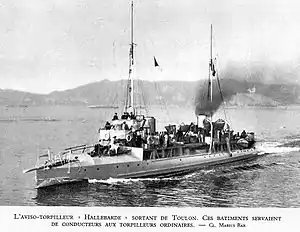French destroyer Durandal
Durandal was the name ship of her class of four destroyers built for the French Navy in the late 1890s.
 Sister ship Hallebarde departing Toulon | |
| History | |
|---|---|
| Name: | Durandal |
| Namesake: | Durendal |
| Ordered: | 25 August 1896 |
| Builder: | Chantiers et Ateliers Augustin Normand, Le Havre |
| Launched: | 11 February 1899 |
| Stricken: | 7 April 1919 |
| Fate: | Sold for scrap, 22 February 1921 |
| General characteristics | |
| Class and type: | Durandal-class destroyer |
| Displacement: | 301 t (296 long tons) |
| Length: | 57.64 m (189 ft 1 in) |
| Beam: | 6.3 m (20 ft 8 in) |
| Draft: | 3.2 m (10 ft 6 in) |
| Depth: | 4.1 m (13 ft 5 in) |
| Installed power: |
|
| Propulsion: |
|
| Speed: | 26 knots (48 km/h; 30 mph) |
| Range: | 2,300 nmi (4,300 km; 2,600 mi) at 10 knots (19 km/h; 12 mph) |
| Complement: | 64 officers and enlisted men |
| Armament: |
|
Design and description
The Durandal class was the first class of destroyers built for the French Navy, and formed part of the 300-tonne type of destroyers, of which 55 ships of similar size and layout were built between 1897 and 1908.[1][2] They were designed by the French specialist builder of torpedo vessels, Chantiers et Ateliers A. Normand, based on their Filibustier-class torpedo boat design, but enlarged and with a stronger hull.[1]
The Durandals were 57.64 m (189.1 ft) long overall and 56 m (183.7 ft) between perpendiculars, with a beam of 5.95 m (19.5 ft) and a draft of 3.20 m (10.5 ft).[3] Displacement was 301 t (296 long tons).[4] Like all the 300 tonne destroyers, Durandal had a "turtleback"[lower-alpha 1] forecastle and a raised flying-deck aft.[6] Two coal-fired Normand water-tube boilers fed steam to two triple-expansion steam engines rated at 4,800 ihp (3,600 kW), giving a design speed of 26 kn (30 mph; 48 km/h).[4] Two widely separated funnels were fitted.[4] The ships had an operating radius of 2,300 nmi (2,600 mi; 4,300 km) at 10 kn (12 mph; 19 km/h) and 217 nmi (250 mi; 402 km) at 26 kn (30 mph; 48 km/h).[3]
Durandal had a gun armament of one Canon de 65 mm Modèle 1891 gun on a raised platform around the ship's conning tower, and six 47 mm (1.9 in)/40 M1885 guns on the ship's beams. Two 380 mm (15 in) torpedo tubes were fitted, with two spare torpedoes carried.[4][3] She had a crew of four officers and 48 other ranks.[3]
Construction and service
Durandal and sister ship Hallebarde were ordered on 25 August 1896, and Durandal was launched at Normand's Le Havre shipyard on 11 February 1899. She reached a speed of 27.42 knots (31.55 mph; 50.78 km/h) during sea trials on 4 July 1899.[3]
In July 1902, Durandal took part in the 1902 French naval manoeuvres in the Mediterranean.[7]
On the outbreak of the First World War, Durandal was based in the English Channel, deployed on anti-submarine duties.[8] On 12 October 1914, Durandal, the destroyer Escopette and the auxiliary cruiser Pas de Calais (a converted paddle packet ship), engaged the German submarine U-20 off Cap Gris-Nez.[9][10]
Notes
- A fore deck with exaggerated camber designed to throw off sea water at high speeds.[5]
Citations
- Chesneau & Kolesnik 1979, p. 323
- Couhat 1974, p. 81
- Couhat 1974, p. 81
- Chesneau & Kolesnik 1979, p. 326
- Gardiner & Lambert 1992, p. 188
- Chesneau & Kolesnik 1979, pp. 323, 326
- Brassey 1903, p. 140
- Fock 1989, p. 379
- Fock 1989, p. 380
- Couhat 1974, pp. 80, 84
Bibliography
- Brassey, T. A., ed. (1903). The Naval Annual 1903. Portsmouth, UK: J. Griffin and Co.
- Caresse, Philippe (2013). "The Unlucky Destroyer Espignole". In Jordan, John (ed.). Warship 2013. London: Conway. ISBN 978-1-84486-205-4.
- Chesneau, Roger & Kolesnik, Eugene M. (1979). Conway's All The World's Fighting Ships 1860–1905. London: Conway Maritime Press. ISBN 0-85177-133-5.
- Couhat, Jean Labayle (1974). French Warships of World War I. London: Ian Allan. ISBN 0-7110-0445-5.
- Fock, Harald (1989). Z-Vor! Internationale Entwicklung und Kriegseinsätze von Zerstörern und Torpedobooten 1914 bis 1939 (in German). Herford, Germany: Koehlers Verlagsgesellschaft mBH. ISBN 3-7822-0207-4.
- Gardiner, Robert; Lambert, Andrew, eds. (1992). Steam, Steel & Shellfire: The Steam Warship 1815–1905. Conway's History of the Ship. London: Conway Maritime Press. ISBN 0-85177-564-0.